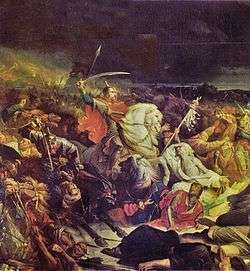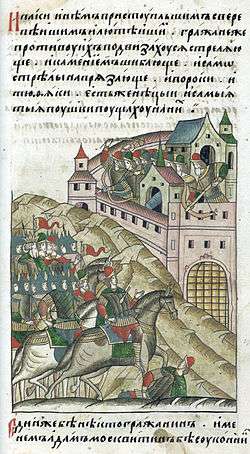Dmitry Donskoy
| Dmitry of the Don | |||||
|---|---|---|---|---|---|
.jpg) | |||||
| Grand Prince of Moscow | |||||
| Reign | 13 November 1359 – 19 May 1389 | ||||
| Predecessor | Ivan II | ||||
| Successor | Vasiliy I | ||||
| Born |
12 October 1350 Moscow, Grand Duchy of Moscow | ||||
| Died |
19 May 1389 (aged 38) Moscow, Grand Duchy of Moscow | ||||
| Burial | Cathedral of the Archangel, Moscow Kremlin | ||||
| Consort | Eudoxia Dmitriyevna | ||||
| Issue |
Daniil Dmitriyevich Yury Vasiliyevich Vasily Dmitriyevich Sofiya Dmitriyevna Yury Dmitriyevich Maria Dmitriyevna Anastasia Dmitriyevna Simeon Dmitriyevich Ivan Dmitriyevich Andrey Dmitriyevich Pyotr Dmitriyevich Anna Dmitriyevna Konstantin Dmitriyevich | ||||
| |||||
| Dynasty | Rurik | ||||
| Father | Ivan II | ||||
| Mother | Alexandra Vasilyevna Velyaminova | ||||
Saint Dmitry Ivanovich Donskoy (Russian: Дми́трий Ива́нович Донско́й,also known as Dimitrii or Demetrius), or Dmitry of the Don, sometimes referred to simply as Dmitry (12 October 1350 in Moscow – 19 May 1389 in Moscow), son of Ivan II the Fair of Moscow (1326–1359), reigned as the Prince of Moscow from 1359 and Grand Prince of Vladimir from 1363 to his death. He was the first prince of Moscow to openly challenge Mongol authority in Russia. His nickname, Donskoy (i.e., "of the Don"), alludes to his great victory against the Tatars in the Battle of Kulikovo (1380), which took place on the Don River.[1] He is venerated as a Saint in the Orthodox Church with his feast day on 19 May.[2][3]
Early reign

Dmitry ascended the throne of the Principality of Moscow at the age of 9. During his minority, Russia's Metropolitan Aleksey ran the government. In 1360 Khizr-khan , Khan of the Golden Horde, transferred the title most prized among Russian princes, that of Grand Prince of Vladimir, to Dmitry Konstantinovich of Nizhniy Novgorod. In 1363, after that prince was deposed, Dmitry Ivanovich was crowned at Vladimir. Three years later, he made peace with Dmitriy Konstantinovich and married his daughter Eudoxia. In 1376 their joint armies ravaged Volga Bulgaria.
The most important event during Dmitry's early reign was start of building the Moscow Kremlin: it was completed in 1367. Thanks to the new fortress, the city withstood two sieges by Algirdas of Lithuania during the Lithuanian–Muscovite War (1368–72). The war ended with the Treaty of Lyubutsk. In 1375, Dmitry settled, in his own favor, a conflict with Mikhail II of Tver over Vladimir. Other princes of Northern Russia acknowledged his authority and contributed troops to the impending struggle against the Horde. By the end of his reign, Dmitry had more than doubled the territory of the Principality of Moscow.
Struggle against Mamai
.jpg)
Mongol domination of parts of what is now Russia began to crumble during Dmitry's thirty-year reign. The Golden Horde was severely weakened by civil war and dynastic rivalries. Dmitry took advantage of this lapse in Mongol authority to openly challenge the Tatars.
While he kept the Khan's patent to collect taxes for all of Russia, Dmitry is also famous for leading the first Russian military victory over the Mongols. Mamai, a Mongol general and claimant to the throne, tried to punish Dmitry for attempting to increase his power. In 1378 Mamai sent a Mongol army, but it was defeated by Dmitry's forces in the Battle of Vozha River. Two years later Mamai personally led a large force against Moscow. Dmitry met and defeated it at the Battle of Kulikovo.
The defeated Mamai was presently dethroned by a rival Mongol general, Tokhtamysh. That khan reasserted Mongol rule over parts of what now is Russia and overran Moscow for Dmitry's resistance to Mamai. Dimitry, however, pledged his loyalty to Tokhtamysh and to the Golden Horde and was reinstated as Mongol principal tax collector and Grand Duke of Vladimir. Upon his death in 1389, Dimitry was the first Grand Duke to bequeath his titles to his son Vasiliy without consulting the Khan.
Marriage and children

He was married to Eudoxia of Nizhniy Novgorod. She was a daughter of Dmitry of Suzdal and Vasilisa of Rostov. They had at least twelve children:
- Daniil Dmitriyevich (c. 1370 – 15 September 1379).
- Vasiliy I of Moscow (30 September 1371 – 27 February 1425).
- Sofia Dmitriyevna. Married Fyodor Olegovich, Prince of Ryazan (reigned 1402–1427).
- Yuriy Dmitriyevich, Duke of Zvenigorod and Galich (26 November 1374 – 5 June 1434). Claimed the throne of Moscow against his nephew Vasiliy II of Moscow.
- Maria Dmitriyevna (d. 15 May 1399). Married Lengvenis.
- Anastasia Dmitriyevna. Married Ivan Vsevolodovich, Prince of Kholm.
- Simeon Dmitrievich (d. 11 September 1379).
- Ivan Dmitriyevich (d. 1393).
- Andrey Dmitriyevich, Prince of Mozhaysk (14 August 1382 – 9 July 1432).
- Pyotr Dmitriyevich, Prince of Dmitrov (29 July 1385 – 10 August 1428).
- Anna Dmitriyevna (born 8 January 1387). Married Yury Patrikiyevich. Her husband was a son of Patrikas, Prince of Starodub and his wife Helena. His paternal grandfather was Narimantas. The marriage solidified his role as a Boyar attached to Moscow.
- Konstantin Dmitriyevich, Prince of Pskov (14 May/15 May 1389 – 1433).
- Descendants Jura Count Von Rathkowich (1923), Momcilio, Michele Count Von Rathkowich (1952),Natalie Franciska Contessa af Sandeberg(1974),Mael Count Correia Von Rathkowich (1992)
Gallery
 Dmitriy Donskoy in the Battle of Kulikovo, by Adolphe Yvon
Dmitriy Donskoy in the Battle of Kulikovo, by Adolphe Yvon Defense of Moscow from Tokhtamysh in 1382
Defense of Moscow from Tokhtamysh in 1382
See also
- Rulers of Russia family tree
- Dmitry Donskoy, opera by Anton Rubinstein (1852).
- Dmitri Donskoi (ship)
References
- ↑ Asimov, Isaac. Asimov's Chronology of the World. New York: HarperCollins, 1989; p. 186.
- ↑ (Greek) Ὁ Ἅγιος Δημήτριος ὁ μεγάλος Πρίγκιπας. 19 Μαΐου. ΜΕΓΑΣ ΣΥΝΑΞΑΡΙΣΤΗΣ.
- ↑ 1 June / 19 May. HOLY TRINITY RUSSIAN ORTHODOX CHURCH (A parish of the Patriarchate of Moscow).
External links
| Wikimedia Commons has media related to Dmitry Donskoy. |
- Cawley, Charles, RUSSIA, Rurik, Medieval Lands database, Foundation for Medieval Genealogy
| Regnal titles | ||
|---|---|---|
| Preceded by Dmitry of Suzdal |
Grand Prince of Vladimir 1362–1389 |
Succeeded by Vasily I |
| Preceded by Ivan II |
Prince of Moscow 1359–1389 |
Succeeded by Vasily I |
| Russian royalty | ||
| Preceded by Ivan II |
Heir to the Russian Throne 1350–1353 |
Succeeded by Daniil Dmitriyevich |
.svg.png)
.svg.png)
